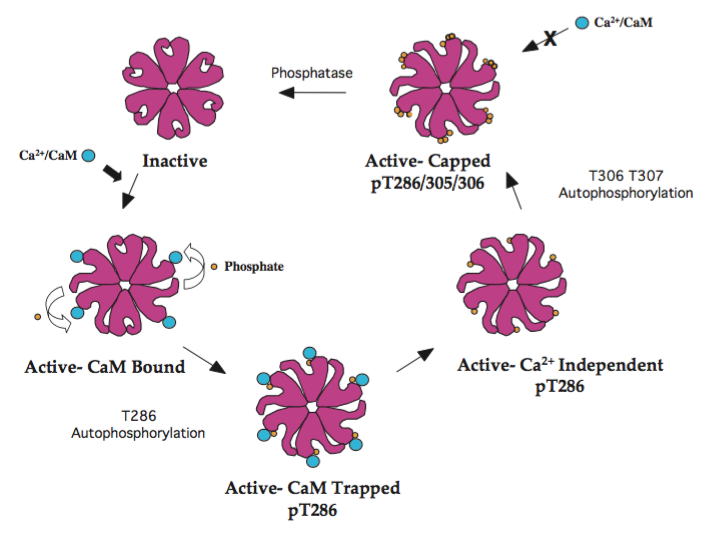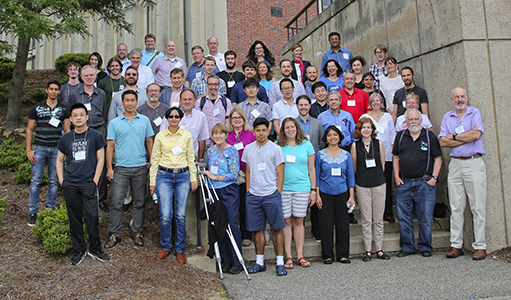The theme of Thursday’s Volen Center for Complex Systems annual retreat will be Breakthroughs in understanding the role of CaMKII in synaptic function and memory and honors the pioneering work of John Lisman. To help bring non-experts up to speed, we asked Neuroscience Ph.D. students Stephen D. Alkins and Johanna G. Flyer-Adams from the Griffith lab at Brandeis for a quick primer on CaMKII.
What’s a protein kinase?
Protein kinases are enzymes that act by adding phosphate groups to other proteins – a process called phosphorylation. Phosphorylation of a protein usually initiates a cascade of downstream effects such as changes in the protein’s 3D shape, changes in its interactions with other proteins, changes in its activity and changes in its localization. In causing these types of changes, kinases facilitate some of the most essential cellular and molecular processes required for survival and proper functionality.
Aren’t there lots of protein kinases? What makes CaMKII special?
Among the roughly 500+ genes in the human genome encoding protein kinases, a kinase known as calcium (Ca2+)/calmodulin-dependent protein kinase II (CaMKII) phosphorylates serine or threonine residues in a broad array of target proteins. Though found in many different tissues (skeletal muscle, cardiac muscle, spleen, etc.), there is a lot of CaMKII in the brain– about 1% of total forebrain protein and 2% of total hippocampal protein (in rats). Previous research, including pivotal contributions from the Lisman Lab at Brandeis University working in mammalian brain, has identified CaMKII as a cellular and molecular correlate of learning and memory through its multiple roles governing normal neuronal structure, synaptic strength, plasticity, and homeostasis. The Griffith Lab has been instrumental in demonstrating that these roles of the kinase are conserved in invertebrates.
Why do we think CaMKII might play a role in memory?
a) Location!
As previously mentioned, CaMKII accounts for up to 2% of all proteins in memory-important brain regions like the hippocampus. It’s also highly abundant at neuronal synapses, where neurons communicate with each other.
b) Function!
Memory is thought to require a process called long term potentiation (LTP) where two neurons, in response to environmental changes, will change the strength of the synaptic connections by which they communicate with each other—these changes will last even after the environmental input has disappeared. We know that CaMKII is required for LTP. We also know that the increases in neuronal calcium levels that accompany neuronal activation and cause LTP also allow CaMKII to phosphorylate itself. This autophosphorylation of CaMKII changes its kinase activity so that CaMKII can stay active well past the window of neuronal activation, essentially ‘storing’ the memory of previous neuronal activity—much like LTP!
c) Structure!
Ultimately, the issue with ‘molecular memory’ is that all proteins degrade over time, causing one to ask how we can remember things for so long when the original proteins that stored that memory no longer exist. CaMKII is such an exciting candidate for molecular memory because it is mostly found as a dodecameric holoenzyme—this means that CaMKII likes to exist as a big assembly of twelve identical CaMKII subunits. However, each CaMKII subunit retains its kinase activity even when all twelve are assembled. What’s interesting is that the autophosphorylation and activation of one CaMKII subunit (which happens when neurons are activated and intracellular calcium levels rise) actually makes it easier for the other CaMKII subunits in the twelve-unit holoenzyme to become autophosphorylated and activated. This means that maybe when an activated subunit is old and get degraded, another new CaMKII subunit could take its place among the twelve-unit holoenzyme—and become activated just like the old subunit, allowing for the ‘molecular memory’ to last beyond when proteins degrade!
 CaMKII in more detail…
CaMKII in more detail…
Calcium binds to the small protein calmodulin and forms (Ca2+/CaM), which acts as a ‘second messenger’ that increases in concentration when neurons are activated. CaMKII relies on calcium/calmodulin (Ca2+/CaM) binding to activate an individual domain containing a regulatory segment. In conditions of low calcium, elements within the CaMKII regulatory segment will have less affinity for (Ca2+/CaM) binding, keeping CaMKII in an autoinhibited state. In conditions of high calcium, (Ca2+/CaM) binding initiates phosphorylation at three threonine residue sites, including Thr286 which prevents rebinding of the regulatory segment, thus keeping CaMKII constitutively active even when calcium levels fall. In this activated state CaMKII can autophosphorylate inactivated intra-kinase domains, and will undergo subunit exchange with neighboring inactivated CaMKII holoenzymes. Furthermore, mutation of CaMKII residues or binding sites in target proteins, such as postsynaptic glutamate (AMPA) receptors, disrupts establishment of long-term potentiation (LTP) in neurons. Together, CaMKII’s role as molecular switch that bidirectionally, and autonomously regulates activity in neurons has earned it the illustrious title of a “memory molecule.”
What amino-acid manipulations might I hear about?
a) T286A:
Changing a threonine in a phosphorylation site to an alanine prevents phosphorylation at that site. Blocking Thr286 phosphorylation with a T286A mutation prevents CaMKII generation of autonomous activity that disrupts neuronal activity and results in learning deficits.
b) T286D:
Changing a threonine to an aspartate puts a negative charge at the site, often making it act like it’s always phosphorylated. In the case of CaMKII, a T286D mutation renders the kinase constitutively active, which can interrupt normal LTP induction and normal memory storage and acquisition.
To learn more:


 The
The  The
The 





 Brandeis Summer Scifest, an Undergraduate Research Poster Session, will be held on Thursday, August 3. The poster session will be 1:00 to 3:00 pm in the Shapiro Science Center atrium.
Brandeis Summer Scifest, an Undergraduate Research Poster Session, will be held on Thursday, August 3. The poster session will be 1:00 to 3:00 pm in the Shapiro Science Center atrium.